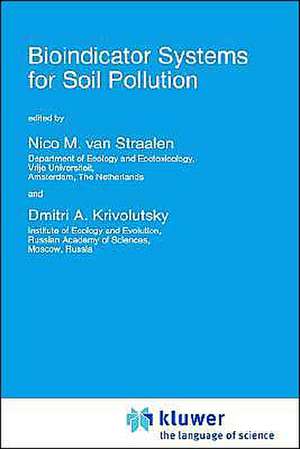Bioindicator Systems for Soil Pollution: NATO Science Partnership Subseries: 2, cartea 16
Editat de N.M. Van Straalen, Dmitri A. Krivolutskyen Limba Engleză Hardback – 31 iul 1996
| Toate formatele și edițiile | Preț | Express |
|---|---|---|
| Paperback (1) | 943.43 lei 6-8 săpt. | |
| SPRINGER NETHERLANDS – 12 feb 2012 | 943.43 lei 6-8 săpt. | |
| Hardback (1) | 949.90 lei 6-8 săpt. | |
| SPRINGER NETHERLANDS – 31 iul 1996 | 949.90 lei 6-8 săpt. |
Din seria NATO Science Partnership Subseries: 2
- 15%
 Preț: 638.43 lei
Preț: 638.43 lei - 5%
 Preț: 1420.29 lei
Preț: 1420.29 lei -
 Preț: 390.84 lei
Preț: 390.84 lei -
 Preț: 401.24 lei
Preț: 401.24 lei - 15%
 Preț: 653.14 lei
Preț: 653.14 lei - 5%
 Preț: 1414.64 lei
Preț: 1414.64 lei - 15%
 Preț: 642.18 lei
Preț: 642.18 lei - 18%
 Preț: 1846.40 lei
Preț: 1846.40 lei - 18%
 Preț: 949.90 lei
Preț: 949.90 lei -
 Preț: 380.07 lei
Preț: 380.07 lei - 15%
 Preț: 643.84 lei
Preț: 643.84 lei - 18%
 Preț: 1839.63 lei
Preț: 1839.63 lei -
 Preț: 416.64 lei
Preț: 416.64 lei - 18%
 Preț: 1234.77 lei
Preț: 1234.77 lei - 18%
 Preț: 1834.90 lei
Preț: 1834.90 lei - 18%
 Preț: 950.96 lei
Preț: 950.96 lei - 15%
 Preț: 655.78 lei
Preț: 655.78 lei -
 Preț: 403.53 lei
Preț: 403.53 lei -
 Preț: 381.98 lei
Preț: 381.98 lei - 18%
 Preț: 1836.94 lei
Preț: 1836.94 lei - 15%
 Preț: 645.47 lei
Preț: 645.47 lei - 18%
 Preț: 946.87 lei
Preț: 946.87 lei - 18%
 Preț: 1227.99 lei
Preț: 1227.99 lei - 18%
 Preț: 1232.57 lei
Preț: 1232.57 lei -
 Preț: 398.15 lei
Preț: 398.15 lei - 18%
 Preț: 1232.71 lei
Preț: 1232.71 lei - 18%
 Preț: 1223.88 lei
Preț: 1223.88 lei - 18%
 Preț: 1228.77 lei
Preț: 1228.77 lei
Preț: 949.90 lei
Preț vechi: 1158.41 lei
-18% Nou
Puncte Express: 1425
Preț estimativ în valută:
181.76€ • 190.28$ • 150.40£
181.76€ • 190.28$ • 150.40£
Carte tipărită la comandă
Livrare economică 05-19 aprilie
Preluare comenzi: 021 569.72.76
Specificații
ISBN-13: 9780792341758
ISBN-10: 0792341759
Pagini: 262
Ilustrații: VI, 262 p.
Dimensiuni: 210 x 297 x 22 mm
Greutate: 0.57 kg
Ediția:1996
Editura: SPRINGER NETHERLANDS
Colecția Springer
Seria NATO Science Partnership Subseries: 2
Locul publicării:Dordrecht, Netherlands
ISBN-10: 0792341759
Pagini: 262
Ilustrații: VI, 262 p.
Dimensiuni: 210 x 297 x 22 mm
Greutate: 0.57 kg
Ediția:1996
Editura: SPRINGER NETHERLANDS
Colecția Springer
Seria NATO Science Partnership Subseries: 2
Locul publicării:Dordrecht, Netherlands
Public țintă
ResearchCuprins
1. Introduction.- Ecotoxicological approaches.- 2. Critical body concentrations: their use in bioindication.- 3. Constraints in the use of bioindicators and biomarkers in ecotoxicology.- 4. Polycyclic aromatic hydrocarbons in soil detritivores.- 5. Sublethal toxicity tests for long-lived iteroparous invertebrates: searching for a solution.- 6. Possible application of fuzzy system simulation models for biomonitoring soil pollution in urban areas.- Community and systems approaches.- 7. Essential criteria for selecting bioindicator species, processes, or systems to assess the environmental impact of chemicals on soil ecosystems.- 8. The maturity index as an instrument for risk assessment of soil pollution.- 9. The use of macro-invertebrates for population and community monitoring of metal contamination - indicator taxa, effect parameters and the need for a soil invertebrate prediction and classification scheme (SIVPACS).- 10. The problem of scale in bioindication of soil contamination.- 11. Biodiversity indicators for sustainability. Assessment of rural landscapes.- Soil invertebrates in bioindication systems.- 12. An integrated bioindication system applied to soil pollution assessments: from earthworms to ecosystems.- 13. Insects in bioindication of soil pollution.- 14. Soil spiders and bioindication.- 15. Soil animals and bioindication.- Bioindicator systems in practice.- 16. Soil fauna as bioindicator of radioactive pollution.- 17. A hierarchical approach to ecological assessment of contaminated soils at Aberdeen Proving Ground, USA.- 18. Bioprocessing of organic wastes: Safety for landspreading them.- 19. Ecotoxicological bioindication: PAH, PCB and heavy metals studied in the natural resource monitoring programme of Berlin (Germany).- 20. Heavy metals in Russian wetlands.- Recommendations.- List of contributors.
Recenzii
` ... therefore the jointly formulated recommendations in the end of the book are not only interesting, but also very useful for those dealing with soil contamination in practice. I recommend this book to anyone involved with management decisions on polluted soils, as well as to academic soil ecotoxicologists and environmental scientists.'
Netherlands Journal of Aquatic Ecology, 30:4 (1997)
Netherlands Journal of Aquatic Ecology, 30:4 (1997)




















